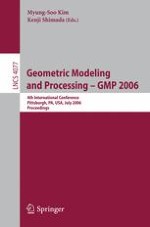2006 | OriginalPaper | Buchkapitel
Inverse Adaptation of Hex-dominant Mesh for Large Deformation Finite Element Analysis
verfasst von : Arbtip Dheeravongkit, Kenji Shimada
Erschienen in: Geometric Modeling and Processing - GMP 2006
Verlag: Springer Berlin Heidelberg
Aktivieren Sie unsere intelligente Suche, um passende Fachinhalte oder Patente zu finden.
Wählen Sie Textabschnitte aus um mit Künstlicher Intelligenz passenden Patente zu finden. powered by
Markieren Sie Textabschnitte, um KI-gestützt weitere passende Inhalte zu finden. powered by
In the finite element analysis of metal forming processes, many mesh elements are usually deformed severely in the later stage of the analysis because of the large deformation of the geometry. Such highly distorted elements are undesirable in finite element analysis because they introduce error into the analysis results and, in the worst case, inverted elements can cause the analysis to terminate prematurely. This paper proposes an inverse adaptation method that reduces or eliminates the number of inverted mesh elements created in the later stage of finite element analysis, thereby lessening the chance of early termination and improving the accuracy of the analysis results. By this method, a simple uniform mesh is created initially, and a pre-analysis is run in order to observe the deformation behavior of the elements. Next, an input hex-dominant mesh is generated in which each element is “inversely adapted,” or pre-deformed in such a way that it has approximately the opposite shape of the final shape that normal analysis would deform it into. Thus, when finite element analysis is performed, the analysis starts with an input mesh of inversely adapted elements whose shapes are not ideal. As the analysis continues, the element shape quality improves to almost ideal and then, toward the final stage of analysis, degrades again, but much less than would be the case without inverse adaptation. This method permits analysis to run to the end, or to a further stage, with few or no inverted elements. Besides pre-skewing the element shape, the proposed method is also capable of controlling the element size according to the equivalent plastic strain information collected from the pre-analysis. The method can be repeated iteratively until reaching the final stage of deformation.
